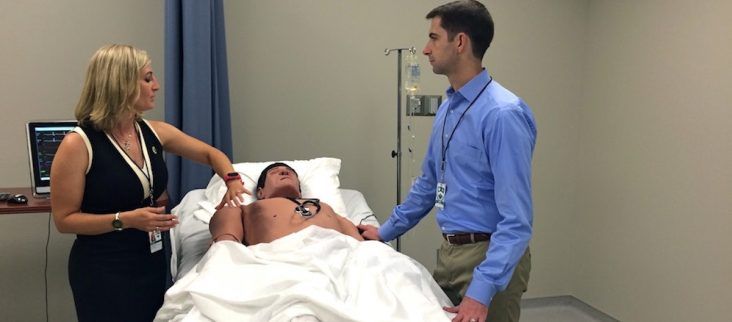Sen. Cotton gets look at first ‘patients’ at Arkansas College of Osteopathic Medicine
by August 8, 2016 3:53 pm 646 views

Dr. Natasha Bray, associate dean at the Arkansas College of Osteopathic Medicine, explains the “Michael” simulator to U.S. Sen. Tom Cotton, R-Ark., during his recent tour of the facility.
The Arkansas College of Osteopathic Medicine (ARCOM) is a year away from opening its doors to its inaugural class of 150, but there is already activity on the sprawling 227-acre campus and, specifically, on the inside of its 102,000 square-foot building at Chaffee Crossing in Fort Smith.
A division of the Arkansas Colleges of Health Education (ACHE), ARCOM is the organization’s $32.4 million “crown jewel” facility, but only the first of other colleges to come. Initial classes will begin in the summer of 2017 and confer the Doctor of Osteopathic Medicine degree (DO). It will be the second osteopathic school to open in Arkansas. Arkansas State University recently opened its osteopathic program on its Jonesboro campus.
The school welcomed its first five patients earlier this year, and Talk Business & Politics along with U.S. Sen. Tom Cotton, R-Ark., met with two of them on Aug. 5.
“Michael” came in having stomach pains, and was quick to tell Dr. Natasha Bray about it. Bray, whose specialty is internal medicine, was hired in January 2015 as an associate dean, and she was the guide for the tour through the new facility.
“How are you feeling?” she asks Michael.
“My stomach hurts.”
“Your stomach’s hurting? I’m sorry.” Bray makes a few adjustments. “Does it feel better now?”
“Yes.”
“Do you want me to leave you alone?”
“I like Sen. Cotton,” Michael says.
Cotton laughs. “We want you to get better, Michael, so you can vote in the next election.”
NOT YOUR TYPICAL PATIENT
It’s not a typical meet-and-greet, but then, Michael is not your typical patient. A lifelike robot in human form – anatomically correct down to his ability to receive Foley catheters – he cost the college around $95,000, a small amount in relation to the technology that accompanies him.
Michael is part of a “high-fidelity simulator” that includes cameras in the ceiling, intricate wiring, and software that can manipulate every part of his health – from sniffles to strokes – for $2.5 million.
“This is how we do clinical exposure from the very beginning,” Bray explains. “We use actors and we use high-fidelity simulators. Michael is an amazing piece of software. I can program him to present any disease presentation that a person can. It’s all done by programming.”
The room features a computer that acts as a monitor, allowing observers to see what’s going on inside of Michael. There is a stethoscope allowing a student to listen to his heartbeat, lung sounds, and gastrointestinal movements.
“I can control his heart rhythm,” Bray explained. “I can control his respiratory rate. I can control what happens neurologically. If I want him to have a stroke, I can change his pupils. So we can really do anything. We can do procedures on him. We can put in chest tubes. We can hook him up to an EKG. We can defibrillate him. We can hook him up to a breathing machine. If we misintubate him, or we don’t do it right, there’s a bag under his stomach that will blow up and we won’t get CO2 returns, so we know we’re not in the right place. That allows students to learn and auto-correct.”
Michael and Lucy – a high-fidelity pregnancy simulator whose mother-and-child robots cost about $150,000 combined – are made by CAE Healthcare, a subsidiary of Canada-based CAE. The robots operate on Wi-Fi, and the computers that allow such a wide range of ailments are all located inside.
PRODUCING ‘EMPATHETIC PROVIDERS’
It is science-fiction come to life, but it serves a greater purpose, according to Bray.
“It’s patient safety,” she said. “When I went to medical school, the adage was ‘See one, do one, teach one.’ You watched someone take care of a patient. You attempted to do it yourself and screwed up and figured it out. Then once you figured it out, you taught someone else how to do it. That’s great if we’re tinkering with toys, but when we’re talking about people’s lives, and making sure we’re providing proper healthcare in a cost effective and appropriate way, our ability to train people on this type of technology allows us to keep our patients safe, and that’s really what we’re about – actually helping people. We don’t want to cause any undue harm or suffering.”
Bray said what ARCOM instructors are looking for with Michael and the other robots is how students interact with patients – particularly how they respond to high-stress situations.
“How do they talk to people? How do they give news? How do they respond when things go terribly wrong and unexpected? What we do in medicine, is based on resilience and how you respond to crisis situations, so giving them those crises and letting them respond in this setting is important.”
And just like human patients, Michael and Lucy and the other robots can die.
“That’s a very harsh reality in our experience,” Bray explained, noting that if a fatality occurs, the student will be brought to the debriefing room and told, “‘I’m really sorry. The patient had an adverse outcome. Your patient’s passed away. Their family is in debriefing. We need you to go and talk to them and deliver that news.’”
Then the students are sent in, and they have to deliver news that a family member has died to crisis actors.
“And that’s extremely difficult,” Bray continued. “Doctors struggle with giving bad news. Some of them do it really badly. So if we can make empathetic providers who are able to deliver that news in a way that’s supportive of families, then we’ve done a good thing.”
At this point, Michael starts snoring. Bray shakes her head.
“He’s heard this speech a thousand times.”
